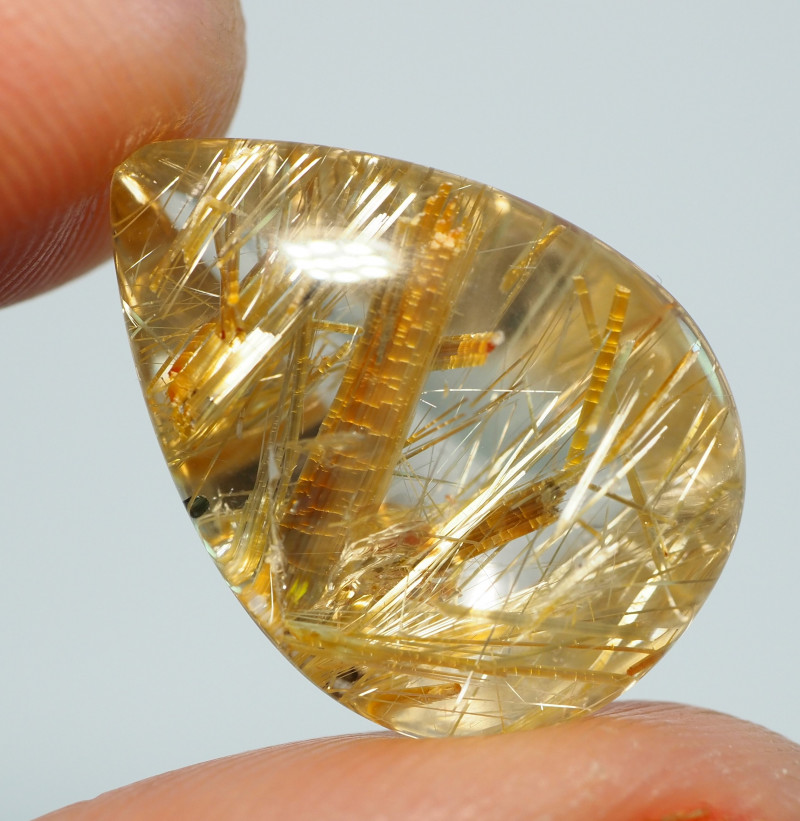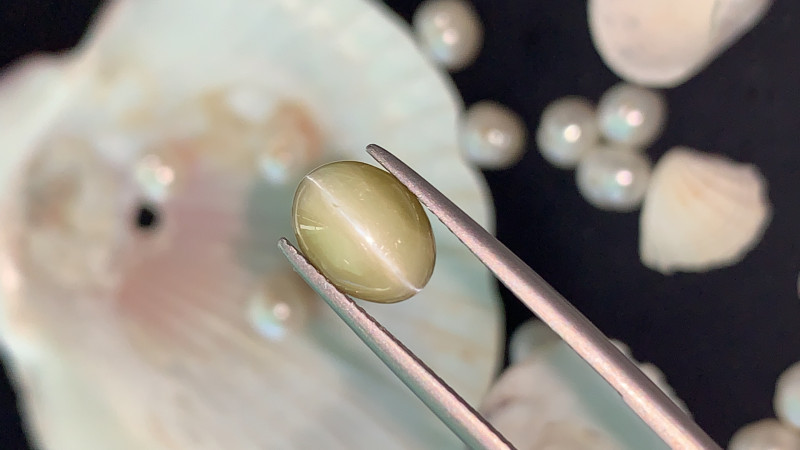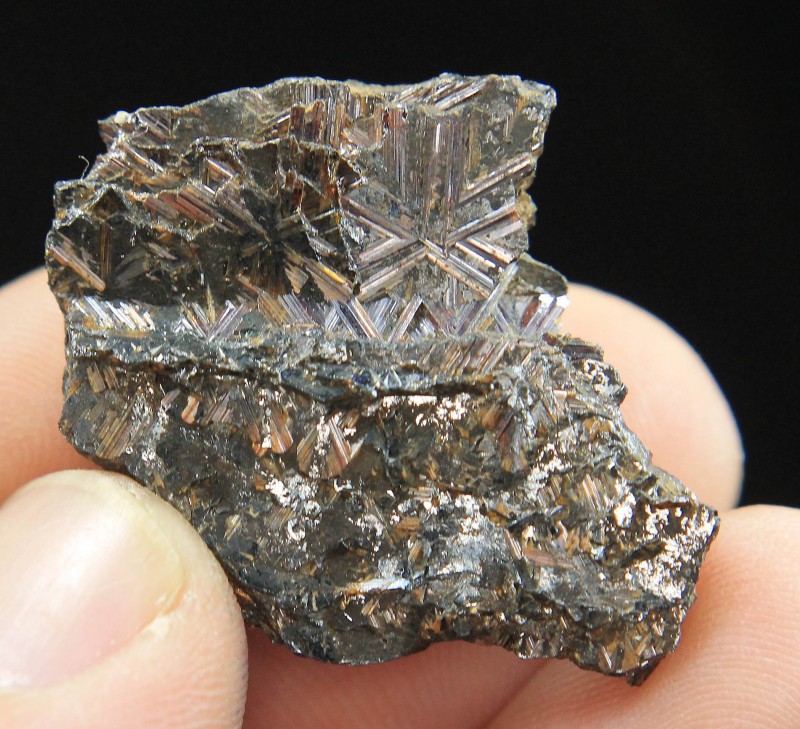
ルチル宝石:特性、意味、価値など
 ルチルは、一般的に金色または赤色の鉱物で、ルチルクォーツなどの他の宝石に含まれることや、あらゆる結晶の中で最も高い屈折率値を持つことで知られています。
ルチルは、一般的に金色または赤色の鉱物で、ルチルクォーツなどの他の宝石に含まれることや、あらゆる結晶の中で最も高い屈折率値を持つことで知られています。
ルチルは希少鉱物ですか?いいえ、そうではありません。実際、ルチルは天然に生成される最も一般的な二酸化チタンです。とはいえ、ファセット加工可能なサイズの宝石品質のルチル結晶はそれほど多くありません。
「ルチルクォーツ」と呼ばれる、金色の針が刺さったタイプのクォーツや、「キャッツアイ」が見られる宝石について聞いたことがあるなら、気づかないうちにルチルに出くわしたことがあるかもしれません。
では、ルチル宝石とは何でしょうか?そして、ルチルとは一体何なのでしょうか?ルチルとルチル宝石の世界を深く掘り下げながら、皆様の疑問にお答えします。
 画像クレジット: Ra'ike | Creative Commons Attribution-Share Alike 3.0 Unportedライセンス
画像クレジット: Ra'ike | Creative Commons Attribution-Share Alike 3.0 Unportedライセンス
ルチル結晶とは何ですか?
ルチル(歴史的には「赤いショール」)は、宝飾品の世界では他の宝石の中に見られることが多いです。個々の結晶はコレクターの宝飾品とされています。ルチルクォーツは、双子座と牡牛座の星座石として用いられています。
最も一般的な天然タイプの二酸化チタンであることに加えて、ニオブとタンタルという 2 つの希少金属も含まれていることがほとんどです。
ルチルは貴重な成分ですが、どのような用途に使用されますか?
工業用ルチルの用途
ルチルの主な工業用途は、以下の製造または抽出です。
白色顔料- 塗料、紙、プラスチックなどに使用
日焼け止め- ナノ粒子が紫外線を吸収する
チタン金属- この鉱物には30%のチタンが含まれています
偏光光学系- 高い屈折率特性により
耐火セラミックス- 冶金学で窯、るつぼなどに使用されます
溶接電極カバー- 金属を大気から保護し、アークを安定させる
ルチルは、その組成に加え、熱、圧力、化学薬品に対する耐性から、屈折セラミックスなどの用途にも使用されています。偏光光学における応用は、その極めて高い屈折率、 分散、複屈折性に由来しています。
ルチルの重要性をさらに理解するために、ルチルは二酸化チタンの最高かつ最も純粋な天然形態(30 パーセントのチタンを含む)であり、二酸化チタンは世界の顔料のおよそ3 分の 2に使用されています。
そうは言っても、ルチルの標本はほとんどの場合他の元素によって不純になっており、それがルチルの鉱物特性につながります。
ルチルの仕様と特徴
ルチルは、化学式TiO2で表される二酸化チタン鉱物です。この石は、錫石を含むルチルグループに属する正方晶系酸化物の中で最も一般的なものです。
この鉱物は、アナターゼとブルッカイトに加え、天然の二酸化チタンの3つの形態の一つです。これら3つはすべて多形性(化学組成は同じですが結晶構造が異なる)を有していますが、ルチルとアナターゼが主な形態です。
アナターゼとルチルはどちらも白色顔料として使われますが、色と吸収率が異なるため、日焼け止めにはルチルのみが使われます。また、ルチル、アナターゼ、ブルッカイトの中で、宝石として最も多く使われているのはルチルです。
針状の結晶インクルージョンを形成しない場合、ルチル結晶は柱状で縦縞模様を呈することが多い。複数の結晶(最大8個)が接触双晶を形成し、時にはループ状の結晶を形成することもある。塊状のルチルや粒状のルチルも見られる。
残りのルチルの特性は次のとおりです。
モース硬度:6~6.5
色: 金色、赤、赤褐色、茶色、黄褐色、緑、黄色、淡い青、紫、黒、灰色、灰黒
結晶構造:正方晶
光沢: 金属光沢、亜金属光沢、または金剛光沢
透明性:透明から不透明
屈折率:2.62~2.90(限度超)
密度:4.20~4.30(鉄含有の場合は4.20~4.40、タンタル含有の場合は4.20~5.60)
裂開:[110]では良好/明瞭、[100]では中程度、[092]と[011]では分離
骨折:貝殻状、貝殻下状、または不均一/不規則
縞模様:灰黒、薄茶色、または薄黄色
発光:なし
多色性:茶色、赤、黄、緑の弱二色性から強二色性あり
光学的効果:時にはシャトヤンシー
複屈折:0.287
分散:0.28~0.33(非常に強い)
次に、個々の特性から、ルチルのさまざまな種類とルチル化された宝石に移ります。
 上の写真:サジェナイトルチル
上の写真:サジェナイトルチル
ルチルの種類
まずはルチルの変種から見ていきましょう。ルチルにはタンタル、ニオブ、鉄が不純物としてよく含まれています。鉄はチタンの一部を置換することもあり、ルチルには最大10%の鉄が含まれることもあります。これがルチルの変種につながります。
イルメノルチル / ニオビアンルチル: 黒色、ニオブ含有変種
ストルヴェライト:黒色、タンタル含有変種。鉄および/またはニオブを含むこともある(ニオブ含有量はタンタル含有量より低くなければならない)
ニグリン:ルチルとイルメナイトの鉄分を豊富に含む変種または組み合わせ
セージナイト:双晶結晶の網目状のネットワークを持つ変種
「セージナイト」は、ルチルアゲート(セージナイトアゲートと呼ばれることもある)や、ルチルやトルマリンの針状の含有物を含むその他のクォーツやカルセドニーの石にも使用されます。
ルチル宝石の種類
他の宝石の場合、 ルチルのインクルージョンは典型的には針状の結晶または微細な繊維です。これらのインクルージョンは複数の方向を向いていたり、密集した束を形成して光学現象を引き起こしたりすることがあります。
ルチル化できる宝石にはどんなものがあるでしょうか?最もよく知られているものから順に、以下にリストアップしてみましょう。
ルチルクォーツ

おそらく最も人気のあるルチルクォーツは、ルチルクォーツ、またはルチルクォーツでしょう。通常、これは透明なクォーツで、内部に金色のルチルの針が貫通しています。針の形、色、大きさは石によって異なり、いくつかの種類があります。
ヴィーナスヘアストーン:金色のルチルを含む品種
スタールチルクォーツ:中心点から6つのインクルージョンが広がり、星型を形成する変種。
グラフィティクォーツ:黒いルチルの針が入った透明なクォーツ
ルチルクォーツはマクロ結晶ですが、ルチルは瑪瑙のような微結晶(カルセドニー)の変種としても出現します。
コランダム(サファイアとルビー)
 上の写真:スターサファイア
上の写真:スターサファイア
サファイアやルビーといった貴重な宝石に内包物があると、通常は石の価値が下がります。しかし、「シルク」と呼ばれるルチル繊維が密集して平行に束ねられると、石の表面に4条または6条の「星」のような反射光(アステリズム)が現れることがあります。この現象は石の価値を高めます。
「スタールビー」や「スターサファイア」って売ってるの見たことありますか?あれはルチルなんです!ブラックスターサファイアの多くはヘマタイトの内包物を持っていますが、タイ産のものにはルチルやヘマタイトの針状結晶から生まれた12条のスターサファイアが入っているものもあります。
ただし、ルチル化が光学的な効果をもたらさない場合、宝石商はルビーを熱処理してルチルを溶解し、透明度を向上させることがあります。
さて、「キャッツアイ」効果はどうでしょうか?
キャッツアイストーン
 上の写真:キャッツアイ石(クリソベリル)
上の写真:キャッツアイ石(クリソベリル)
ルチルクォーツの石の表面に複数の光線ではなく 1 本の反射光線がある場合、それはシャトヤンシー効果または「キャッツアイ」効果と呼ばれます。
最も強い例は、単に「キャッツアイ」と呼ばれるシャトヤンシーのクリソベリルに見られます。その他のシャトヤンシーの石も、その名前に倣う必要があります(例: キャッツアイ シリマナイト)。
その他のシャトヤントルチル石には以下のものがあります:
シャトヤンシーは、タイガーアイのように、石の繊維状または層状の構造によっても引き起こされることがあります。ルチルクォーツの単体でもシャトヤンシー効果を発揮することがあります。
ルチルを含むその他の宝石
 上の写真:ルチルを含むトルマリン宝石
上の写真:ルチルを含むトルマリン宝石
多くの宝石にはルチルが含まれていますが、光学的な効果は見られません。例えば、アクチノライト、トレモライト、ルチル、雲母を含むクォーツは「魔女の指」と呼ばれます。他にも以下のような宝石があります。
ふぅ、ルチルの宝石ってこんなにたくさんあるんですね! では、ルチルの象徴性について見ていきましょう。

ルチル宝石の意味と歴史
ルチルは悟り、直感、そして天界との繋がりを象徴します。興味深いことに、現在では使われなくなった19世紀の「ルチル」の定義は「輝く」または「光線を発する」という意味です。
中世ヨーロッパの占い師たちは、ルチルが精神的な架け橋であると信じ、ルチルクォーツを使って依頼人の過去、現在、そして未来を見通すとしていました。
ルチルクォーツに含まれるルチルは「天使の髪」や「キューピッドの矢」とも呼ばれ、様々な女神と結び付けられています。
古代ギリシャ・ローマ人にとって、ルチルクォーツは「美と愛の女神、ヴィーナス(またはアフロディーテ)の髪」でした。伝説の中には、女神の髪の毛が落ちて神話上の生き物や氷に閉じ込められたことでルチルクォーツが形成されたという説もあります。
中世のヴァイキングは、ルチルは北欧神話の中心的な女神の一人であるフレイヤに由来すると信じていました。フレイヤは美、愛、そして人生のより良いものを象徴する点で、ヴィーナスと似ています。
 上の写真:チタニア(合成ルチル)|画像提供: FlickrのJames St. John
上の写真:チタニア(合成ルチル)|画像提供: FlickrのJames St. John
歴史
ルチルの名称は、ラテン語で「赤みがかった」を意味するrutilusに由来し、当初研究対象となった標本の色に由来しています。ドイツの地質学者アブラハム・ゴットロブ・ヴェルナーが1800年に自身の記述でこの名称を採用しましたが、これが最初の名前ではありませんでした。
ルチルの最初の記述は、1772年にオーストリアの鉱物学者兼冶金学者イグナツ(またはイグナティウス)・フォン・ボルンによって、スロバキア産の標本に基づいてなされました。彼はそれを「 Basaltes crystallisatus ruber 」(ラテン語で「赤い結晶のショール」を意味する)と名付けました。
1783年、フランスの鉱物学者ジャン=バティスト・ルイ・ロメ・ド・リルはマダガスカルでルチルクォーツを発見し、それを「 schorl rouge ou purpre 」(フランス語で「赤または紫のショール」)と名付けました。
12 年後の 1795 年、ドイツの化学者マルティン・ハインリヒ・クラプロートは、現在のスロバキア産ルチルからチタン(公式に知られる前)を発見し、それを「hungarischen rother schörl」(ドイツ語で「ハンガリーの赤いショール」)と名付けました。
その後まもなく、1796年にジュネーブの地質学者オレス・ベネディクト・ド・ソシュールは、スイスの双晶ルチルについて記述し、ギリシャ語またはラテン語の「網」を意味する「 sagena 」に由来する「サジェナイト」と名付けました。
同じく1796年、アイルランドの地質学者リチャード・カーワンはルチルを「チタナイト」(現在はスフェーンに使われている)と名付けました。フランスの鉱物学者ルネ・ジュスト・アユイも同様に1801年にルチルを「チタン・オキシデ」(フランス語で「酸化チタン」)と名付けました。
ルチルの原産地は、時代を超えて様々な記述がなされてきたため、議論の的となってきました。当初は1800年のヴェルナーの記述に基づき、オルカフエロ・デ・ラ・シエラと考えられていましたが、21世紀の研究により、真の原産地はスロバキアのレヴーカであることが示されました。
現代では、ルチルは1948年に初めて合成されました。これらの石は、より耐久性の高い選択肢が登場するまでの数年間、ダイヤモンドの模造品(「チタニア」という名前で)として販売されていました。

ルチルの治癒特性
ルチルは、ルチルを含む多くの宝石と同様に、ヒーリングストーンとして用いられます。レッドルチルは、他の赤い宝石と同様に、活力、モチベーション、情熱をもたらします。ゴールデンルチルは、他の黄色い宝石と同様に、希望、成功、喜びをもたらします。
チャクラ石としてのルチルは、チャクラ システム全体に恩恵をもたらし、7 つのエネルギー センターすべてを開いて調整するため、完全にバランスが取れ、ポジティブなエネルギーを受容できるようになります。
身体の治癒
ルチルは慢性疾患、疲労、エネルギー不足に効果があると言われています。また、不妊治療にも効果があると信じられています。
感情的な癒し
ルチルクリスタルの感情的な効能として、ストレス、羞恥心、恐怖症の解消などが挙げられます。クリスタルヒーラーは、願望をより効果的に実現するために、意図を設定する際にルチルを活用することを推奨しています。
ルチルは治癒効果以外に価値があるのでしょうか?それはその特性によります。

ルチル宝石の特性
ルチル宝石の価値は、色、カット、透明度、カラット重量、そして合成石かどうかによって決まります。
色
ルチルの多くは、赤、金、茶色、黒といった秋の色合いをしており、これらはすべて鉄に由来します。ニオブやクロムは緑色の色合いを作り出すこともあります。
最も価値の高いルチルの色は鮮やかな黄金色と銅色の赤ですが、珍しい青や紫の色合いもコレクターの間で人気があります。
カット
ダイヤモンドの6倍もの分散を持つルチルは、適切なファセットカットが施されると、他に類を見ない輝きを放ちます。しかし、この効果は合成ルチルで最も顕著です。天然のファセットカット石は、通常、色が濃すぎる(または光沢が金属的すぎる)ため、分散が目立ちません。
魅力的で美しい色のルチルをファセットカットした宝石は非常に価値があります。
ルチルがシャトヤンシー効果を持つ場合、その効果を発揮するにはカボションカットにする必要があります。
明瞭さ
クラリティ(宝石に含まれる目に見える内包物の量)は透明度に影響を与えることがあります。透明なルチルが最も価値が高いため、内包物のない透明な石が最高級品となります。
カラット重量
ルチルは透明でファセット加工可能な部分を持つほど大きな結晶を形成することもありますが、ファセット加工された宝石の中では、より大きなサイズになると色が濃くなりすぎてしまいます。そのため、ファセット加工されたルチルのほとんどは3カラット未満です。
トリートメントと合成
天然ルチルはコレクションでは一般的ですが、 合成ルチルは一般的に透明度が高く色も優れているため、その分散がよく見えるため、ジュエリーではより一般的です。
チョクラルスキー法、ベッヒャー法(イルメナイトを使用)、または火炎溶融法で製造されます。通常は欠陥がありませんが、まれにガスの泡が見られることがあります。
天然ルチルは処理されていませんが、合成ルチルは加熱処理によって淡黄色から青色に変化することがあります。合成ルチルは、赤、黄色、茶色の場合もあります。
合成物とは対照的に、ルチルが自然界でどのように形成されるかを見てみましょう。

ルチルの形成と産地
ルチルは火成岩や変成岩に含まれており、高温高圧の条件下で形成されます。具体的には、アルプスの鉱脈、ペグマタイト、片麻岩、片岩、石灰岩、砕屑岩(風化した岩石の破片)に含まれています。
採掘場所
現在、ルチルの最大の生産国はシエラレオネで、全ルチルの約3分の1を供給しています。スイスは、より透明度の高い天然ルチルの生産で知られています。
その他の重要なルチルの産地は以下のとおりです。
ブラジル
フランス
ミャンマー
パキスタン
ロシア
スリランカ
アメリカ合衆国(アーカンソー州、カリフォルニア州、ジョージア州、ノースカロライナ州、サウスダコタ州、バージニア州)
もちろん、ルチルの購入を検討する際には、価格が最も重要な要素かもしれません。

ルチルの価格と価値
ルチルは比較的お手頃ですが、最も高価なのはファセットカットの宝石です。合成ファセットカットの宝石は1カラットあたり約40~100ドルです。天然ファセットカットのルチルも同様に、1カラットあたり40~90ドルですが、中には1カラットあたり10ドル以下のものもあります。
ルチルの原石は通常1カラットあたり1ドル以下です。結晶がしっかりと形成されたものは、1カラットあたり7.50ドル程度と少し高くなることもあります。
キャッツアイ ルチル カボションの価格は 1 カラットあたり 13 ドルから始まり、1 カラットあたり 125 ドルまで上がります。
ルチルクォーツをお探しですか?この石は比較的お手頃な価格です。マルチカラーの石は1カラットあたり0.60ドルから15ドルで、ほとんどが低価格帯です。カボションは1カラットあたり5ドル以下ですが、需要の高まりにより、最近では1カラットあたり20ドル近くまで価格が上昇しています。
ルチルのケアとメンテナンス
最後に、 宝石のお手入れについてご説明します。ルチルは硬度が中程度であるため、特に傷つきやすいルチルリングやルチルブレスレットなど、あらゆるジュエリーに保護セッティングをお勧めします。
ルチルのお手入れは簡単です。ぬるま湯と低刺激性石鹸を混ぜ合わせ、その混ぜ合わせたものに浸した柔らかい歯ブラシで優しくこすります。石鹸カスを洗い流した後、柔らかく埃のない布で乾かします。他の宝石とは分けて保管してください。
ルチルに夢中ですか?
ルチルは、通常は他の宝石に対して目立たない存在ですが、金色の輝きで周囲の人々を高揚させるためには、注目の中心になる必要はないということを私たちに思い出させてくれます。
Gemstone Encyclopedia検索
最新記事
レインボーラティスサンストーンは、様々な内包物によって3つのゴージャスな光学的効果を持つ長石の一種です。燃えるように鮮やかな色合いと格子模様が、コレクターにとって希少な宝石となっています。
12th Jan 2026
チューライトは、ゾイサイト鉱物ファミリーに属する、鮮やかなバラ色の色合いを示す希少なノルウェー産の宝石で、ジュエリーのセッティングやペンダントによく使用されます。
6th Jan 2026
記事のカテゴリ
How To's is where you will find helpful articles from gem Rock Auctions on how to cut gemstones, select gemstones and buy gemstones.
9記事数
